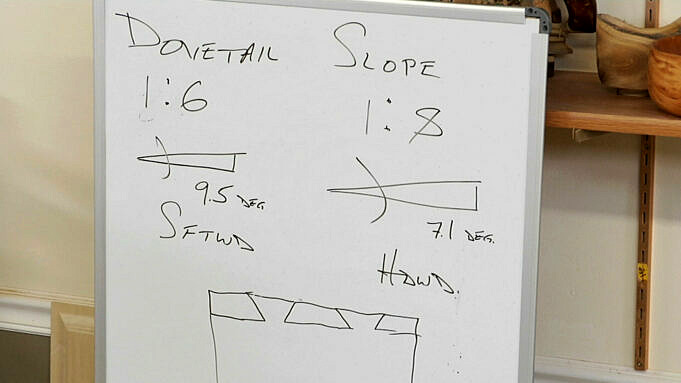My take on dovetail angles might appear to be strange, but I have solid reasons for my choice , if I do say so myself. Here goes.
Most commonly, dovetail angles can be described in degrees. However, it is more common to describe them as a ratio of 1:8 and 1:6. These ratios translate into a 7? or a 9? angle. These are the established angles; the angles were suppose to bow to upon pulling our marking gauges from the bench drawer as we prepare to cut the parts of the joint. For softwoods (9), one angle is recommended (a better term might be required). The other is for hardwoods.
Do you really need two sets? One set is for softwood dovetails and one for hardwoods. Why would you want to purchase tools that do the exact same task, only at a different angle? Where is the dovetail joint most commonly used? It is used in drawer construction. Many woodworkers use a combination of hardwood drawer fronts with either hardwood sides (poplar) or softwood sides (pine). There are many combinations. However, I believe these are the most popular in American antiques during the major furniture periods of Queen Anne and Chippendale.
I use Newport, R.I., as a demarcation line for typical woods used to build drawers and if youre building reproduction furniture from Newport south (not Southern designs that use yellow pine as a secondary wood), you are probably using two hardwoods for your drawer parts; poplar as the sides, backs and bottoms with another primary hardwood as your drawer fronts. Traditionally, 7 is the recommended height for these two hardwoods. slope.
What about those of us who build drawers from New England designs? Designs north of Newport, R.I. where drawers are made from hardwood and softwood (namely pine) as the drawer parts. What angle should we choose for our dovetails: 7? that matches the use of hardwood, or 9? Softwoods: It’s a puzzle.
We also have the dovetail-jigs, which suggest (here’s that word again), that we use a 14?dovetail router bit for making the tails and an straight bit to cut pins. I can say I like the slope of these dovetails much better. These dovetails are more appealing to me aesthetically. And thats what I think should drive your dovetail angles , aesthetics.
Dont accept the traditional ratios. I’m willing to bet that a study of drawer and furniture constructions from the 1700s onwards would reveal many different dovetail angles. The 7?, 9 and 14? dovetail angles have been used by me. and 14? angles, I used dovetail joints jigs during this period. It is almost impossible for beginners to follow the layout lines so I bet I used some angles when I switched to hand-cutting dovetails. I know of no joint failures and not once have I seen the angles break or shear along the slope of the tail (something preached if the slope grows well beyond the traditional ratios).
The Angle I Use
So, where am I today with this dovetail angle question? I use a 12? angle. Why 12?, you may ask? Let me tell you. I certainly wasnt going to switch angles depending on the application (too much wasted time) and I wanted an angle that fit somewhere in the middle of the established slopes. How many places is the number 12 found in our world? There are 12 months in one year. Two sets of 12 hours in a day. Most people know that a dozen of anything is 12. To make it more consistent with woodworking, you will need to cut the panels at a 12? angle if you are fitting a raised panel in a 1/10cm groove.
And most important, I like the angle when I look at it.
Are you crazy? Am I crazy? (I’m sure that I will get some comments on this question. Remember the glove incident?) What degree slope do you use for your dovetails and why?



